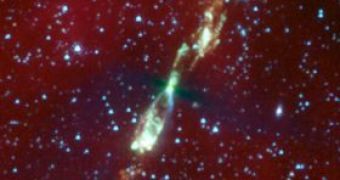The infrared view of the Spitzer Space Telescope shows, for the first time, the early stage of a sun-like structure, when the cloud of dust and gas surrounding it is being flattened and collapsed into a thin disk gravitating it in an approximate equatorial region. The presence of the ejected streams of gas from the stars' poles and the cloud gas could help astronomers in better understanding the process of stellar and solar system formation.
The infrared images clearly show the flattened envelope around the embryonic star, named L1157. Previous theories regarding solar system formations predicted that the gas cloud would be flattened and collapsed into a disk around the star, which would provide the material for future planets to form; however, it is the first time when an image showing clear evidence about it has been captured.
All the stars form in large thick clouds of gas and dust, a so-called envelope, which will eventually start to spin, condense and collapse on itself, creating a star that grows larger by drawing the surrounding gas of the envelope, fact that will make it spin faster and faster. As the star accumulates more and more matter, it will become slightly unstable, because of the high amounts of energy it generates, and it will eject streams of gas in the regions of its poles, in order to relieve part of the accumulated pressure. The streams of gas create pressure on the surrounding gas cloud, forcing it to compress and flatten into a spinning disk around the new born star, while the material ejection gradually slows down, until it stops.
However, the space where the new stars are formed is usually surrounded by dark dusty clouds, which filter the visible spectrum of the light. On the other hand, these clouds of dust and gas can be easily penetrated by infrared radiation, which is picked up by the Spitzer Space Telescope in order to give us the rare view of how teenage solar systems looks like.
Calculations regarding the length of the bipolar jets, emitted by the L1157 star, reveal that even the light from the star would need at least nine months to travel the distance of one of the jet streams' length. Infrared images show that the parts of the jet which glow in white light, have an approximated temperature of about 100 degrees Celsius, while the material glowing in orange has a estimated temperature of 0 degrees Celsius.
The disk of material, spinning around the young star, has a perpendicular position relative to the gas streams and appears in deep black, because it is relatively thick and the infrared light is all filtered through it and cannot escape. Estimations on the dimensions of the surrounding envelope suggest that it is large enough to house about ten thousand solar systems similar to our own, while the disk of material that could eventually form planets is so small, that it cannot be seen in the image.
The star L1157 is about 10,000 years old, and it will become a main-sequence star in about a million years. It is located in the Cepheus constellation, at a distance of about 800 light-years from our solar system.

 14 DAY TRIAL //
14 DAY TRIAL //